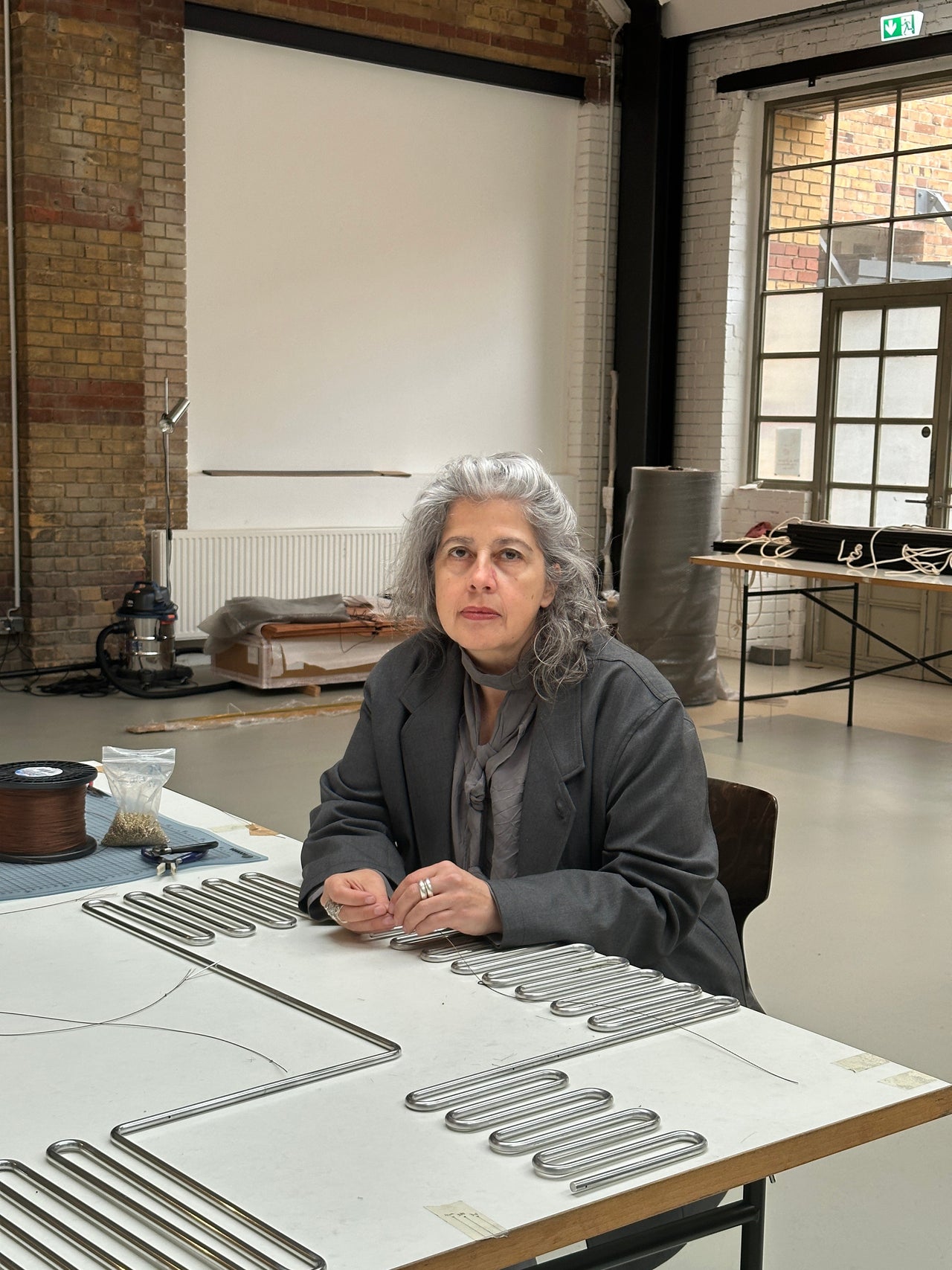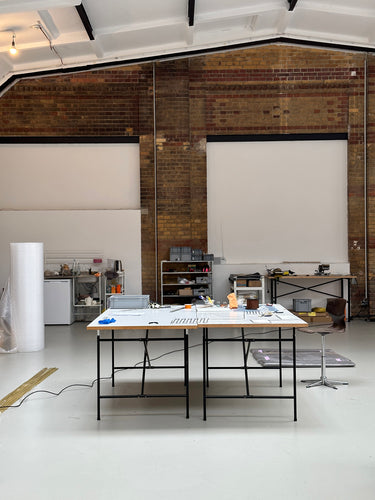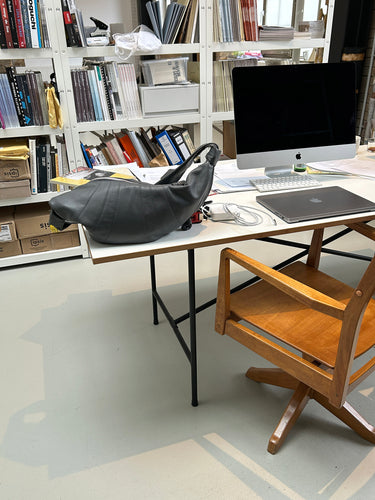Voo Visits
Voo Visits: Leonor Antunes
- Words
- Marie Wez
- Photography
- Javier de la Blanca

Voo Visits

We spoke to the artist about the poetry of craftsmanship, the power of collaboration and the importance of passing on knowledge.
Voo Store: You have quite an impressive collection of books here. Do you collect them for inspiration?
Leonor Antunes: No, not for inspiration. I work a lot with archives and references to other people’s work so I need them for my process. For example this one (holds up a book), is about this Japanese artist I am very interested in, Michiko Yamawaki. It’s the only book about her work, she isn’t as recognised sadly. She was an artist and weaver and the only Japanese artist who studied at Bauhaus at the time. I’m currently working on a commission for a building in Tokyo where I’m referencing her work. It's part of the Mori group and curated by Mami Kataoka. I take fabrics or patterns she designed, I measure and translate them in a new context.
V: Like a dialogue.
L: Yes. I always think of people that weren’t as recognised at their time. And I like to collaborate with people, other artists and artisans. For my next exhibition at the Fruitmarket in Edinburgh, I am working with a fantastic writer and friend of mine, Briony Fer, who is curating the show. I’ll be turning around a cork floor-piece engraved with a pattern taken from Marian Pepler, who is a designer and architect from the 1930s. I’ll also be showing some of my previous works, a leather piece made from Ananas, a leatherpiece and another one made from bamboo that are based on parts of a Perriand chair. A few years ago, I did a lot of ceramic works based on one of Perriand’s lamps, the one she designed for the Japanese ambassador in Paris.


V: So it also the matter of space that is interesting to you.
L: I mean everything has a meaning, right. And sometimes it really is just a small detail that catches my attention that I then translate into my work. I like to engage with the spaces I exhibit in, whether through their historical context or the space itself. When I did the Portuguese Pavilion in Venice, I worked with a lot of local artisans, glassblowers and wood makers. I collaborated with the same workshop as Carlos Scarpa, I really wanted to activate the craftsmanship that already existed in the city.
V: I feel like true craftsmanship is not as valued these days, not in the same measure as it used to be at least. So by collaborating with local workshops, you’re also ensuring that these crafts survive and receive a platform.
L: Yes, exactly. When I work with leather for example, I always work with the same man in Portugal. His craft is not really considered as important, sadly. He is a saddle maker. I know how to work with leather and some works I do myself, but others I ask him to produce for me because I find it important to give him work and it allows him to continue doing what he’s doing. He has passed on a lot of his knowledge to me, too.
V: A personal exchange.
L: Totally. If I didn’t know him, I probably wouldn’t do this. Once Hèrmes reached out and thought about commissioning me for a project, but I thought it would have been too much connected to design. Of course they have incredible crafts people, but I’m not interested in that. I’m interested in working with people and community, work with and support them.


V: How do you feel about fashion and art?
L: I love clothes, but I don’t like fashion. As much as I like architecture but there are also so many great minds who just haven’t been properly recognised. I think my job as an artist is also to give them credit. And in fashion, I am often disappointed by the lack of research and consideration for the craft and people behind it. There is this amazing shop in Mexico City, that was created only to support and exhibit different weavers and artisans, and he makes sure they are very well-paid. They have the most beautiful fabrics, everything is hand-dyed. It’s incredible. They use back strap looms attached to their waist and it takes about six months to make a dress.
V: People often don’t realise how much effort it takes to make clothes.
L: They don’t. I actually met this lady in Lisbon. She’s a weaver and an artist herself, she mainly creates commissioned work. So I tried to collaborate with her, she did a series of weaving for me with this silk straw we found in Brazil. It’s hand-dyed using different fruit and vegetables. I think I have some samples here.


V: Do you go on sourcing trips where you just focus on sourcing materials or do you pick them up on the way?
L: Sometimes I go to places to do research, places I find interesting and relevant for my work. Sometimes it happens that I have a show somewhere and I try to see and research as much as possible. I have all these boxes with things that I found and keep for reference. I have this Mexican lasso made from animal skin and I love the way it is braided. I have this horse hair trench that I also love and seed-beaded crafts that were gifted to me from an Amazonian tribe in Brazil. Then other times, I find things that I love and they are still waiting for their time.
V: What is the meaning behind the ropes?
L: In the beginning it was really about this idea of construction a space using a line or in this case, a rope. You know, it weaves in the space and you can create volumes with it. I am doing a lot of things that are hanging from the ceiling and it’s not always possible to hang stuff so I use ropes as my kind of grid or structure. I weave the ceiling. It allows me to make separations in space.


V: Do you make samples to see what the silhouette of the hanging sculptures is going to be?
L: No, I just hang them randomly. It doesn’t really matter. It's activation and gravity. For me, the important part is the reference of a piece. It’s always different when you hang it.
V: So how did you get to Berlin?
L: I came here in 2005 for a residency at the Künstlerhaus Bethanien in Kreuzberg. I did a lot of residencies before, but I never really liked to live in any of the previous cities. But I really liked Berlin, there are so many artists here. So I decided to stay and I live here with my husband and my daughter. I actually made a lamp called Olga, that’s my daughter’s name.
V: Is this the green one?
L: Yes. I make one every year. It represents both of our heights and it grows with her. So they are all different, they all have different colours. She chooses the colours. It's made out of two tubes, the inner tube is my height and the outer tube is her height. She is now taller than me so I have to make a new one and you will see only her tube. I have to think about how to do it though.


Voo Visits is a series introducing new and old friends of Voo, like-minded creatives and people from Berlin who inspire us.